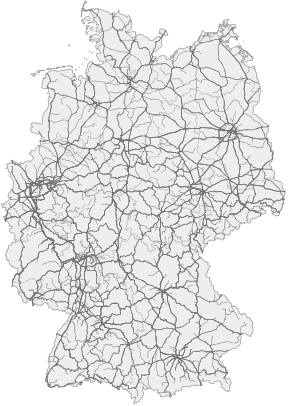
Back Ferrocarril en Alemania Spanish Transport ferroviaire en Allemagne French Németország vasúti közlekedése Hungarian ドイツの鉄道 Japanese Jernbane i Tyskland NB Transport kolejowy w Niemczech Polish Transportul feroviar în Germania Romanian Железнодорожный транспорт в Германии Russian Järnväg i Tyskland Swedish การขนส่งระบบรางในประเทศเยอรมนี Thai
| Rail transport in Germany | |||||
|---|---|---|---|---|---|
 An ICE 3 approaching Köln Hauptbahnhof | |||||
| Operation | |||||
| National railway | Deutsche Bahn | ||||
| Statistics | |||||
| Ridership | 2.87 billion (2018)[1] | ||||
| Passenger km | 97.8 billion (2018)[1] | ||||
| Freight | 116 billion tkm (2018)[1] | ||||
| System length | |||||
| Total | 33,399 kilometres (20,753 mi) (2022, Deutsche Bahn only)[2] | ||||
| Double track | 18,556 kilometres (11,530 mi) (2022, Deutsche Bahn only)[2] | ||||
| Electrified | 20,540 kilometres (12,760 mi) (2022, Deutsche Bahn only)[2] | ||||
| Track gauge | |||||
| Main | 1,435 mm (4 ft 8+1⁄2 in) | ||||
| Electrification | |||||
| Main | 15 kV 16.7 Hz
S-Bahn Berlin 750 V S-Bahn Hamburg 1200 V | ||||
| |||||
As of 2021[update], Germany had a railway network of 33,399 kilometres (20,753 mi), of which 20,540 kilometres (12,760 mi) were electrified and 18,556 kilometres (11,530 mi) were double track.[2] Germany is a member of the International Union of Railways (UIC). The UIC Country Code for Germany is 80.
Germany was ranked fourth among national European rail systems in the 2017 European Railway Performance Index assessing intensity of use, quality of service and safety.[3] Germany had a very good rating for intensity of use, by both passengers and freight, and good ratings for quality of service and safety.[3] Germany also captured relatively high value in return for public investment with cost to performance ratios that outperform the average ratio for all European countries.[3]
Germany's rail freight of 117 billion tons/kilometer meant it carried 17.6% of all inland German cargo in 2015.[4]
- ^ a b c Cite error: The named reference
destatis8/2was invoked but never defined (see the help page). - ^ a b c d "Railway Statistics 2022 Report" (PDF).
- ^ a b c "the 2017 European Railway Performance Index". Boston Consulting Group. 8 January 2021.
- ^ "Is the German Rail Freight System broken? A portrait of DB Cargo | Combined Transport". 4 September 2017.
